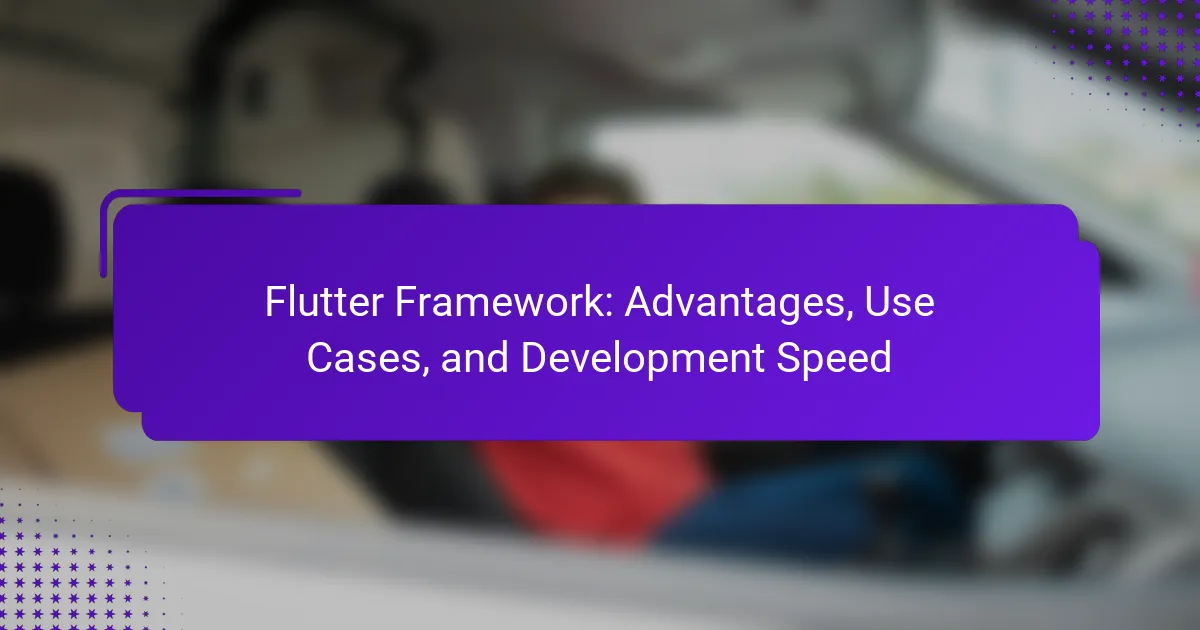Flutter is an open-source UI software development toolkit developed by Google, designed for building natively compiled applications across mobile, web, and desktop platforms from a single codebase. The framework utilizes the Dart programming language and offers a rich set of pre-designed widgets, enabling fast and expressive user interface development. Key advantages of Flutter include its hot reload feature, which allows developers to see changes in real time, and its cross-platform capabilities that significantly reduce development time and costs. Common use cases for Flutter encompass mobile, web, and desktop application development, making it a preferred choice for businesses looking to create interactive applications, MVPs, and visually appealing user experiences.

What is the Flutter Framework?
Flutter is an open-source UI software development toolkit created by Google. It allows developers to build natively compiled applications for mobile, web, and desktop from a single codebase. Flutter uses the Dart programming language, which is optimized for building user interfaces. The framework provides a rich set of pre-designed widgets that facilitate fast and expressive UI development. Flutter’s architecture includes a reactive framework, which simplifies the process of building interactive applications. It also features a hot reload capability, enabling developers to see changes in real time without restarting the app. This significantly speeds up the development process and enhances productivity. Flutter has gained popularity for its performance and flexibility in creating cross-platform applications.
How does the Flutter Framework operate?
The Flutter Framework operates by using a single codebase to create applications for multiple platforms. It compiles to native ARM code for high performance on both iOS and Android. Flutter utilizes a widget-based architecture, allowing developers to build user interfaces by composing widgets. Each widget is an immutable description of part of the user interface. Flutter’s rendering engine draws these widgets directly onto the screen, providing smooth animations and transitions. The framework also supports hot reload, enabling developers to see changes in real-time during development. This increases development speed and efficiency. The Dart programming language is used for writing Flutter applications, which enhances performance and productivity.
What are the key components of the Flutter Framework?
The key components of the Flutter Framework are widgets, the Dart programming language, and the Flutter engine. Widgets are the building blocks of a Flutter app’s user interface. They define the structure, layout, and behavior of the app. The Dart programming language is used for writing Flutter applications. It offers features like hot reload, which allows developers to see changes in real-time. The Flutter engine is responsible for rendering and providing low-level services. It enables smooth animations and high-performance graphics. Together, these components create a cohesive framework for building cross-platform applications.
How does the architecture of Flutter contribute to its functionality?
The architecture of Flutter enhances its functionality through a layered structure. This structure consists of three main layers: the framework, the engine, and the embedder. The framework provides a rich set of widgets and tools for building user interfaces. It enables developers to create responsive and customizable designs easily.
The engine, built in C++, handles low-level rendering and communication with the platform. This allows for high performance and smooth animations. The embedder integrates Flutter with the host operating system, enabling seamless interaction with native features.
Flutter’s architecture supports hot reload, which allows developers to see changes in real-time. This significantly speeds up the development process. The combination of these layers ensures that Flutter applications are efficient, expressive, and maintainable.
What are the core features of the Flutter Framework?
The core features of the Flutter Framework include a rich set of pre-designed widgets, hot reload functionality, and cross-platform development capabilities. Flutter provides a comprehensive library of widgets that allow developers to create visually appealing applications. The hot reload feature enables developers to see changes in real-time without restarting the application. Flutter’s architecture supports building applications for multiple platforms from a single codebase. This significantly reduces development time and effort. Additionally, Flutter uses the Dart programming language, which enhances performance and productivity. The framework also offers a strong community and extensive documentation, making it easier for developers to learn and implement. These features collectively contribute to Flutter’s growing popularity in mobile app development.
How does Flutter support cross-platform development?
Flutter supports cross-platform development by allowing developers to write a single codebase for both iOS and Android applications. This framework uses the Dart programming language, which compiles to native code, ensuring high performance across platforms. Flutter’s widget-based architecture enables the creation of responsive UIs that adapt to different screen sizes and resolutions. Additionally, Flutter provides a rich set of pre-designed widgets that facilitate rapid development and customization. The framework also includes a hot reload feature, which allows developers to see changes in real-time without restarting the application. This significantly speeds up the development process and enhances productivity. Flutter’s strong community support and extensive libraries further contribute to its effectiveness in cross-platform development.
What role does the Dart programming language play in Flutter?
Dart is the primary programming language used in Flutter. It enables developers to build natively compiled applications for mobile, web, and desktop from a single codebase. Dart’s syntax is easy to learn, making it accessible for developers. Flutter uses Dart’s Just-In-Time (JIT) compilation for faster development cycles. This allows for hot reload, which speeds up the development process. Dart also provides Ahead-Of-Time (AOT) compilation for optimized performance in production. The integration of Dart with Flutter enhances UI creation through its widget-based architecture. Overall, Dart is essential for Flutter’s functionality and performance.

What advantages does the Flutter Framework offer?
The Flutter Framework offers advantages such as fast development, expressive UI, and cross-platform capabilities. Its hot reload feature allows developers to see changes instantly, enhancing productivity. Flutter uses a single codebase for both iOS and Android, reducing development time and effort. The framework provides a rich set of pre-designed widgets, enabling customized and visually appealing applications. Additionally, Flutter supports high performance through its Skia graphics engine, delivering smooth animations and transitions. It also has strong community support and extensive documentation, making it easier for developers to find resources and solutions. Overall, these advantages make Flutter a popular choice for mobile app development.
How does Flutter enhance development speed?
Flutter enhances development speed through its hot reload feature. This allows developers to see changes in real-time without restarting the application. Consequently, modifications can be tested immediately, reducing iteration time. Flutter also provides a rich set of pre-designed widgets. These widgets simplify the UI development process and minimize the need for custom design work. Additionally, Flutter supports cross-platform development. This means a single codebase can be used for both iOS and Android applications. As a result, developers save time and resources by avoiding duplicate work. Overall, Flutter’s features streamline the development process significantly.
What tools and features contribute to faster development in Flutter?
Flutter offers several tools and features that contribute to faster development. Hot Reload allows developers to see changes in real-time without restarting the app. This significantly speeds up the testing and iteration process. The Flutter widget library provides a rich set of pre-designed components. These components reduce the need for custom coding and streamline UI development.
Additionally, the Dart programming language, used by Flutter, is optimized for fast development. Dart’s strong typing and asynchronous programming capabilities enhance performance and maintainability. Flutter’s command-line tools simplify project setup and management. These tools automate repetitive tasks, allowing developers to focus on coding.
Finally, extensive documentation and community support accelerate the learning curve. Resources such as tutorials and forums provide quick solutions to common issues. Together, these tools and features make Flutter an efficient framework for rapid application development.
How does hot reload impact the development process?
Hot reload significantly accelerates the development process in Flutter. It allows developers to see changes in the code instantly without restarting the application. This feature enhances productivity by reducing the time spent on debugging and testing. Developers can make adjustments to the user interface and logic in real-time. Consequently, this leads to a more iterative and responsive development cycle. According to the Flutter documentation, hot reload preserves the application state, which further streamlines the workflow. This capability is particularly beneficial for UI-heavy applications where frequent updates are common. Overall, hot reload fosters a more efficient and dynamic development environment.
What are the performance benefits of using Flutter?
Flutter offers high performance due to its native compilation capabilities. It compiles to ARM or x86 native libraries. This results in faster startup times and improved runtime performance. Flutter’s architecture allows for efficient rendering using the Skia graphics engine. The engine enables smooth animations and transitions. Flutter also benefits from a reactive framework that minimizes the need for frequent updates. This enhances performance by reducing the workload on the CPU. Additionally, Flutter’s hot reload feature allows for quick iterations during development. This leads to faster debugging and testing cycles. Overall, these factors contribute to a highly efficient development experience and application performance.
How does Flutter optimize app performance across devices?
Flutter optimizes app performance across devices by using a high-performance rendering engine called Skia. Skia allows Flutter to draw widgets directly onto the screen, which enhances rendering speed and reduces latency. Flutter’s architecture is designed to compile to native ARM code, which improves performance on both Android and iOS devices. Additionally, Flutter employs a reactive framework, which efficiently updates the UI by only rebuilding the parts of the widget tree that need to change. This minimizes unnecessary redraws and optimizes resource usage. Flutter also includes a rich set of pre-built widgets that are optimized for performance, ensuring smooth animations and transitions. Furthermore, Flutter’s hot reload feature allows developers to see changes in real-time, enhancing development efficiency without compromising performance.
What advantages does Flutter provide in terms of user experience?
Flutter provides several advantages in terms of user experience. It enables smooth animations and transitions, enhancing the visual appeal of applications. Flutter’s widget-based architecture allows for customizable UI components, leading to tailored user experiences. The framework supports hot reload, which facilitates real-time updates during development, improving responsiveness. Flutter applications maintain high performance across platforms, ensuring consistency in user experience. Additionally, it provides a rich set of pre-designed widgets that adhere to both Material Design and Cupertino guidelines. This versatility allows developers to create natively compiled applications for mobile, web, and desktop from a single codebase, streamlining the user experience across different devices.

What are the common use cases for the Flutter Framework?
Common use cases for the Flutter Framework include mobile application development, web application development, and desktop application development. Flutter allows developers to create cross-platform applications from a single codebase. This significantly reduces development time and costs. Businesses often use Flutter for creating MVPs (Minimum Viable Products) due to its rapid development capabilities. Additionally, Flutter is ideal for building highly interactive applications with smooth animations. Many companies leverage Flutter for e-commerce apps, social media platforms, and productivity tools. Its widget-based architecture makes it easy to customize UI components. Overall, Flutter is widely adopted for projects requiring fast iteration and a native-like user experience.
Which types of applications are best suited for Flutter?
Flutter is best suited for applications that require a high-performance, visually appealing user interface. This includes mobile applications for both iOS and Android platforms. Flutter’s single codebase allows for rapid development and easier maintenance. Applications with complex animations and transitions benefit from Flutter’s rendering capabilities. Additionally, applications needing quick iterations during development are ideal for Flutter. E-commerce apps, social media platforms, and productivity tools are commonly built using Flutter. The framework’s hot reload feature enhances developer productivity by allowing real-time updates. Companies like Alibaba and Google Ads demonstrate Flutter’s effectiveness in real-world applications.
How is Flutter used in mobile app development?
Flutter is used in mobile app development to create natively compiled applications for mobile, web, and desktop from a single codebase. This framework allows developers to write code in Dart, which is then transformed into native machine code. Flutter provides a rich set of pre-designed widgets that facilitate user interface design. It also supports hot reload, enabling developers to see changes in real time without restarting the app. The framework’s performance is enhanced by its use of the Skia graphics engine. This allows for smooth animations and transitions. Flutter’s cross-platform capabilities reduce development time and costs significantly. According to a survey by Stack Overflow, Flutter is one of the most loved frameworks among developers, indicating its growing popularity in the industry.
What are some examples of successful Flutter applications?
Some examples of successful Flutter applications include Google Ads, Alibaba, and Reflectly. Google Ads allows users to manage their advertising campaigns efficiently. Alibaba uses Flutter to enhance its e-commerce platform with smooth user experiences. Reflectly is a personal journal app that leverages Flutter for its visually appealing interface. These applications showcase Flutter’s capability to create high-performance, visually attractive apps across different industries.
How does Flutter compare to other frameworks in specific scenarios?
Flutter excels in cross-platform mobile app development compared to other frameworks. It offers a single codebase for both iOS and Android, significantly reducing development time. In scenarios requiring high-performance graphics, Flutter’s Skia engine provides smooth animations and transitions.
When building user interfaces, Flutter’s widget-based architecture allows for customizable designs. This flexibility is advantageous for apps needing unique branding. In contrast, React Native often requires native components for complex UI, which can increase development complexity.
For rapid prototyping, Flutter’s hot reload feature facilitates instant updates during development. This feature is not as efficient in Xamarin or native development frameworks. Additionally, Flutter’s strong community support and extensive libraries enhance its usability in various scenarios.
Overall, Flutter’s performance, UI flexibility, and development speed make it a strong contender against other frameworks in specific app development scenarios.
What are the strengths of Flutter in comparison to React Native?
Flutter offers several strengths compared to React Native. Firstly, Flutter provides a single codebase for both iOS and Android, enhancing development efficiency. This framework utilizes the Dart programming language, which compiles to native code, resulting in improved performance. Flutter’s widget-based architecture allows for highly customizable user interfaces.
Additionally, Flutter includes a rich set of pre-designed widgets, which accelerates the UI development process. The hot reload feature enables developers to see changes instantly, speeding up the development cycle. Flutter also has strong support for animations, making it easier to create visually appealing applications.
In contrast, React Native relies on JavaScript, which may introduce performance overhead. Flutter’s comprehensive documentation and active community support further enhance its usability. These strengths position Flutter as a compelling choice for cross-platform development.
In what situations might developers prefer Flutter over traditional native development?
Developers might prefer Flutter over traditional native development in situations requiring cross-platform compatibility. Flutter allows for a single codebase to run on both iOS and Android. This reduces development time and costs significantly. For projects with tight deadlines, Flutter’s hot reload feature speeds up the development process.
Additionally, developers may choose Flutter for its rich widget library, which simplifies UI development. This is particularly beneficial for teams with limited resources. Flutter also offers excellent performance due to its direct compilation to native code. This can lead to smoother user experiences compared to traditional methods.
In cases where rapid prototyping is needed, Flutter’s flexibility supports quick iterations. This makes it ideal for startups and MVPs (Minimum Viable Products). Overall, developers favor Flutter when efficiency, speed, and cross-platform functionality are priorities.
What best practices should developers follow when using Flutter?
Developers should follow several best practices when using Flutter. First, they should organize code using a clear folder structure. This enhances maintainability and readability. Next, developers should utilize Flutter’s built-in widgets effectively. This helps to create a consistent user interface.
Additionally, they should manage state efficiently. Using state management solutions like Provider or Riverpod can simplify this process. Developers should also write unit and widget tests. This ensures code reliability and helps catch bugs early.
Moreover, they should keep dependencies updated. This minimizes security vulnerabilities and improves performance. Finally, developers should leverage the Flutter community resources. Engaging with forums and documentation can provide valuable insights and solutions.
The Flutter Framework is an open-source UI software development toolkit created by Google, enabling developers to build natively compiled applications for mobile, web, and desktop from a single codebase using the Dart programming language. This article explores the advantages of Flutter, including fast development, expressive UI, and cross-platform capabilities, as well as its key components such as widgets and the Flutter engine. Additionally, it discusses how Flutter enhances development speed through features like hot reload, and outlines common use cases and scenarios where Flutter excels compared to other frameworks. Overall, the article provides a comprehensive overview of Flutter’s functionality, performance benefits, and best practices for developers.
